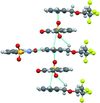issue contents
August 2017 issue

Cover illustration: Solid-state geometries of [(![[eta]](/logos/entities/eta_rmgif.gif) 6-C6H5)(2-F-C6H4)]Cr(CO)3 and [(
6-C6H5)(2-F-C6H4)]Cr(CO)3 and [(![[eta]](/logos/entities/eta_rmgif.gif) 6-C6H5)(4-F-C6H4)]Cr(CO)3 indicate exclusive coordination of the metal center to the more electron-rich arene ring. Unlike the structures of the free ligands, the chromium complexes exhibit no crystallographic symmetry and no positional disorder. See Guzei, Spencer, Buechel, Kaufmann & Czerwinski [Acta Cryst. (2017), C73, 638-644].
6-C6H5)(4-F-C6H4)]Cr(CO)3 indicate exclusive coordination of the metal center to the more electron-rich arene ring. Unlike the structures of the free ligands, the chromium complexes exhibit no crystallographic symmetry and no positional disorder. See Guzei, Spencer, Buechel, Kaufmann & Czerwinski [Acta Cryst. (2017), C73, 638-644].
research papers






















 journal menu
journal menu



























